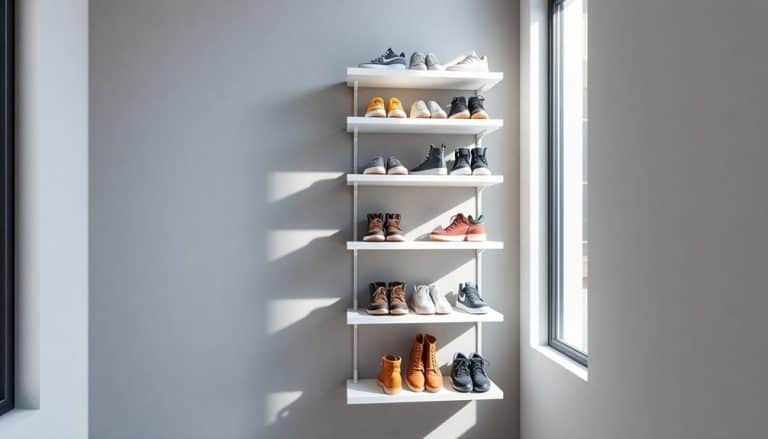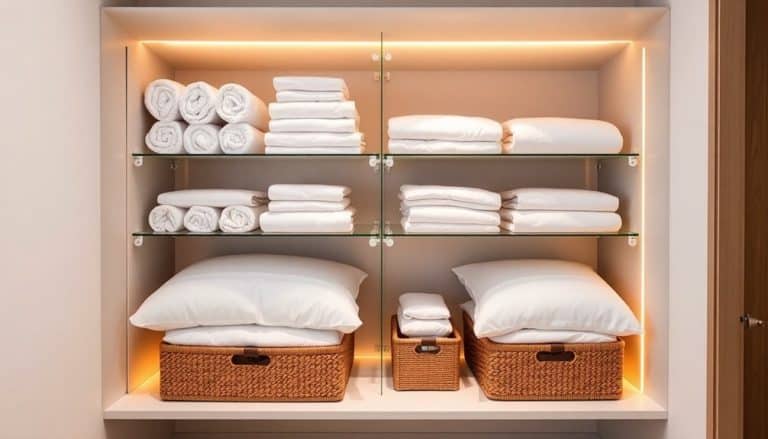This website contains affiliate links. Some products are gifted by the brand to test. As an Amazon Associate, I earn from qualifying purchases. The content on this website was created with the help of AI.
You’ll maximize your home gym storage by combining vertical and hidden solutions. Install wall-mounted systems with heavy-duty brackets and pegboards to keep weights, resistance bands, and yoga mats off the floor while ensuring easy access. Utilize multi-purpose furniture like storage ottomans and benches to conceal smaller equipment, and take advantage of dead spaces under stairs or behind sliding panels. For tight spaces, opt for over-the-door organizers and corner shelving units that can support up to 55 pounds. With proper planning and organization, your workout space can transform into an efficient, clutter-free environment. Let’s explore specific strategies to optimize every square inch.
Key Takeaways
- Install wall-mounted storage systems with heavy-duty brackets to safely store weights and equipment while maximizing floor space.
- Utilize dual-purpose furniture like storage ottomans and benches to conceal workout gear while maintaining a clean living space.
- Add pegboards and slatwall panels to customize storage options for various equipment types and adapt as your collection grows.
- Convert unused spaces like under-stair areas and corners into storage zones with specialized shelving units and compartments.
- Implement clear labeling systems and group similar items together for quick access during workouts and efficient organization.
Vertical Storage Solutions

Making the most of vertical wall space is essential for storing home workout equipment efficiently. You’ll find that installing wall-mounted storage systems maximizes floor space while keeping your gear organized and accessible. Start by mounting sturdy pegboards or slatwall panels that can hold various attachments for different equipment types. Add hooks, brackets, and specialized holders to accommodate resistance bands, yoga mats, and jump ropes.
Install weight plate storage pegs at different heights to organize plates by size, guaranteeing they’re secure and easy to access. For dumbbells, mount a vertical rack or use individual cradles spaced appropriately for your specific weights. Consider installing floating shelves or wall-mounted cabinets to store smaller items like exercise bands, gloves, and fitness trackers.
Don’t forget to utilize over-the-door space with specialized hangers for yoga mats or resistance bands. For stability balls, install wall-mounted cradles or suspension nets that keep them off the floor. When mounting any storage solution, verify weight limits and use appropriate wall anchors to guarantee safety. Position frequently used items at eye level and less-used equipment higher up or lower down. For maximum safety and stability, ensure your wall-mounted storage solutions can support up to 600 pounds per shelf when properly installed.
Hidden Equipment Storage

How can you keep your workout equipment out of sight while maintaining easy access? Transform everyday furniture into dual-purpose storage solutions. Place resistance bands and yoga mats in ottoman benches that open from the top, or slide dumbbells under your bed using wheeled storage containers. Install drawer organizers in deep cabinets to separate smaller items like hand grips and jump ropes.
Convert dead space into hidden storage areas by installing sliding panels behind doors or creating false walls with recessed shelving. You’ll find that the space between wall studs can accommodate lighter equipment when you install cabinet-style doors. Under-stair storage compartments work perfectly for larger items like kettlebells and medicine balls.
Consider furniture with built-in storage capabilities. A TV stand with closed cabinets can house your collection of workout DVDs and smaller equipment, while a window seat with deep drawers provides perfect storage for foam rollers and yoga blocks. Install murphy-style wall-mounted shelving that folds flat when not in use, or use decorative screens to section off a dedicated workout equipment zone that you can easily conceal when guests arrive. For maximum mobility and organization, invest in portable storage carts that can be easily moved between workout spaces and storage areas.
Wall-Mounted Organization Systems

While hidden storage keeps your space tidy, wall-mounted systems maximize vertical space and provide instant access to your fitness gear. You’ll find various options, from basic pegboard systems to sophisticated modular panels that accommodate different equipment types.
Install weight rack holders to store dumbbells and kettlebells safely off the floor. Choose heavy-duty brackets rated for your weights’ load capacity, and mount them directly into wall studs. For resistance bands and jump ropes, use sturdy hooks or specialized band hangers that prevent tangling and maintain the equipment’s shape.
Consider installing an adjustable slatwall system, which lets you reconfigure hooks and shelves as your equipment collection grows. You’ll need horizontal bars for storing yoga mats and foam rollers, while mesh baskets work well for smaller items like gloves and exercise bands. Don’t forget to include dedicated spots for towels and water bottles.
Before mounting any system, measure your wall space carefully and plan the layout based on your equipment’s dimensions. You’ll want to position frequently used items at eye level and heavier equipment lower on the wall for safety and accessibility.
Multi-Purpose Furniture for Equipment

Today’s multi-purpose furniture offers clever solutions for storing workout equipment without sacrificing your living space’s style or functionality. You’ll find ottomans that open to store yoga mats, resistance bands, and small weights, while serving as comfortable seating. Storage benches can house dumbbells and kettlebells while doubling as workout surfaces for step-ups or bench presses.
Consider investing in a coffee table with hidden compartments where you can tuck away exercise accessories and resistance bands. Many modern designs feature lift-top mechanisms that transform into standing desks or dining surfaces. You’ll also benefit from bed frames with built-in drawers perfect for storing foam rollers, exercise balls, and workout gear.
Look for hallway consoles that incorporate storage cubbies for your workout shoes and equipment while maintaining their decorative purpose. Media centers with adjustable shelving can accommodate both your entertainment system and exercise equipment. Some furniture manufacturers now offer specialized pieces like credenzas with ventilated compartments for storing sweaty gear and equipment that needs to breathe. These practical solutions help you maintain an organized, clutter-free space while keeping your workout essentials within reach. For enhanced organization and visibility, use non-toxic clear bins inside your furniture compartments to keep equipment sorted and easily accessible.
Small-Space Storage Hacks

Living up to your fitness goals in a compact space requires strategic storage solutions that maximize every inch. You’ll need to think vertically and utilize often-overlooked spaces in your home to keep your workout equipment organized and accessible.
Transform dead space into storage gold by installing pegboards on your walls to hang resistance bands, jump ropes, and lightweight equipment. Don’t forget to use the back of doors – they’re perfect for over-the-door organizers that can hold yoga mats, foam rollers, and small weights. Corner spaces, which often go unused, can accommodate tall, narrow shelving units designed specifically for your gear.
For heavier workout equipment, install heavy-duty metal hooks that can support up to 55 pounds when properly mounted into wall studs.
Here’s how to maximize typically wasted spaces:
- Install floating shelves above doorways to store rarely-used equipment like seasonal gear or backup supplies
- Utilize the space under your bed with rolling storage containers for yoga blocks, exercise bands, and smaller items
- Convert closet dead zones with tension rods to hang multiple resistance bands, boxing gloves, or suspension trainers
Remember to label everything clearly and group similar items together. You’ll want quick access to your equipment when it’s time to work out, so prioritize frequently used items at eye level.
Frequently Asked Questions
How Often Should I Clean and Maintain Stored Workout Equipment?
Time flies when you’re building strength, but don’t let equipment maintenance slip through the cracks. You’ll need to wipe down your gear after each use to prevent sweat buildup and bacteria. Deep clean your equipment weekly using appropriate cleaning solutions. Check for loose parts, rust, or wear monthly, and lubricate moving components every three months to extend their lifespan and guarantee safe workouts.
Can Storing Equipment in Humid Basements Damage My Workout Gear?
Yes, storing equipment in humid basements can seriously damage your workout gear. Metal components will rust, fabric materials can develop mold, and rubber parts might deteriorate faster. You’ll want to keep humidity levels below 50% using a dehumidifier, install proper ventilation, and elevate equipment off the floor. If you must use your basement, wrap metal equipment in moisture-barrier materials and check items regularly for early signs of damage.
What’s the Weight Limit for Storing Multiple Dumbbells on One Shelf?
You’ll need to check your shelf’s specific load rating, as weight limits vary by material and construction. For standard household shelving, don’t exceed 50-75 pounds per linear foot. Metal industrial shelves can handle 200-400 pounds per shelf level. When storing dumbbells, distribute the weight evenly and consider reinforcing the mounting brackets. It’s safer to spread heavier weights across multiple lower shelves to prevent sagging or collapse.
Should I Disassemble Larger Equipment Before Storing It Long-Term?
You mean you’re not planning to deadlift your treadmill into storage as-is? Smart thinking! Yes, you’ll want to disassemble larger fitness equipment before long-term storage. Take photos of the assembly process in reverse, keep all screws and parts in labeled bags, and store the manual with the equipment. This protects the machinery, saves space, and makes it easier to move. Plus, you won’t forget how to put it back together later.
How Can I Prevent Rubber Mats From Sticking Together in Storage?
To prevent rubber mats from sticking together, dust them with talcum powder or cornstarch before stacking. You’ll want to store them flat, not rolled, with wax paper or parchment paper between each layer. Keep them in a cool, dry place away from direct sunlight, and don’t stack them too high. If you’re storing long-term, check them periodically and reapply powder if needed.




